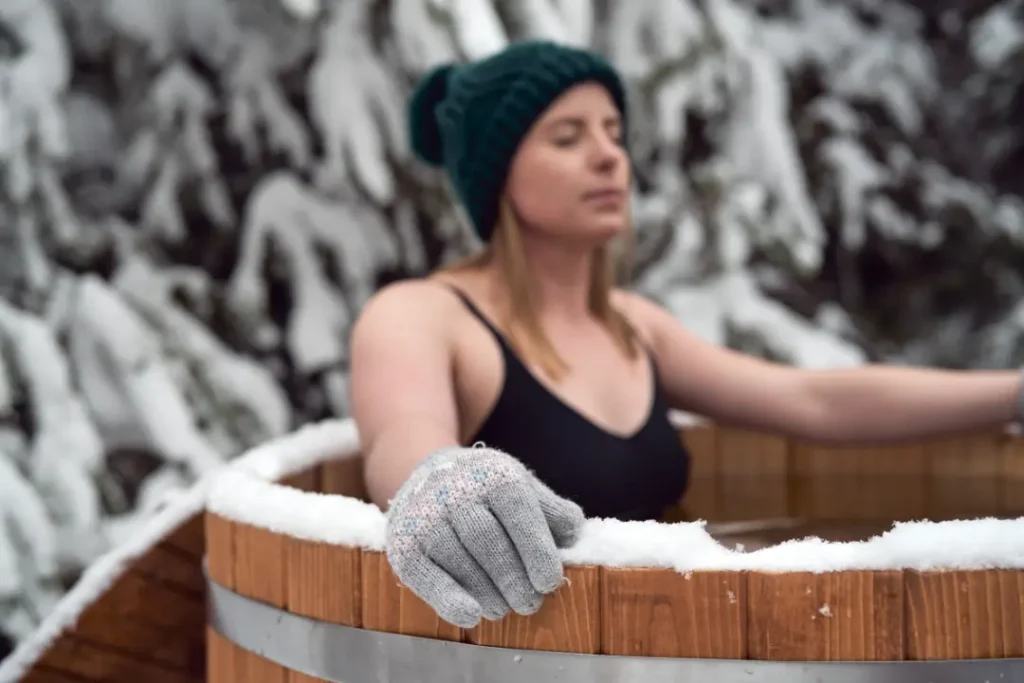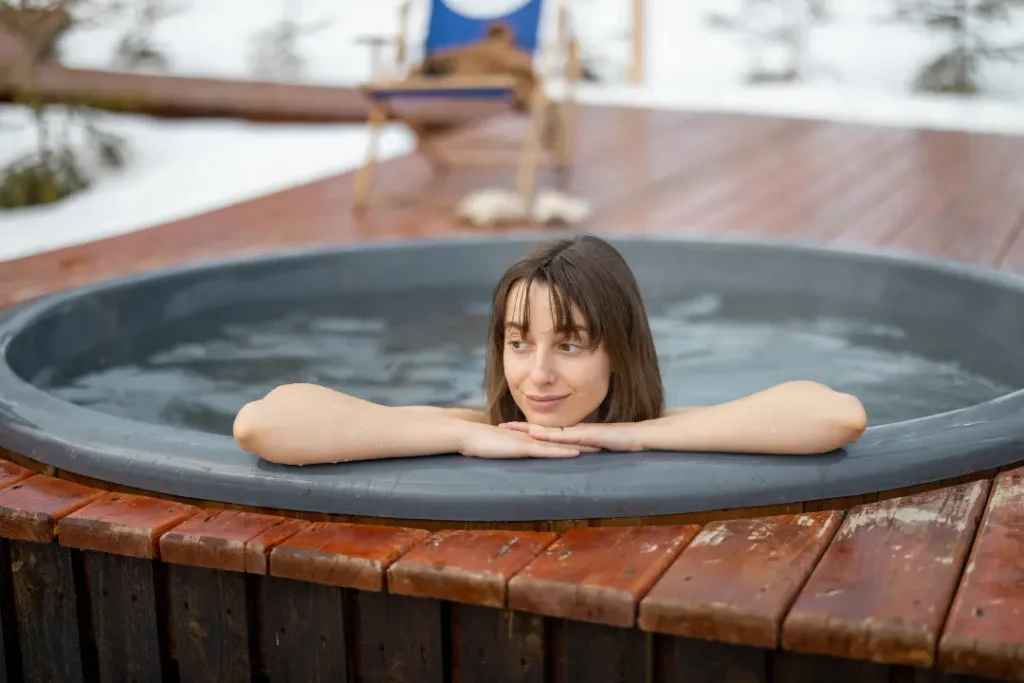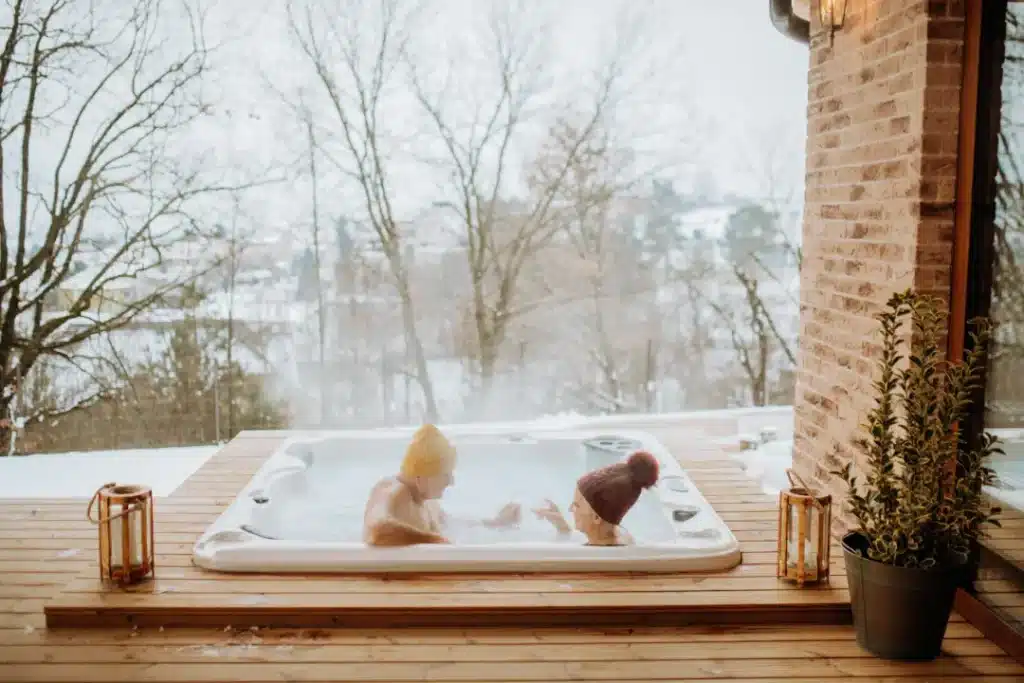If you are asking can I leave my hot tub empty for winter? The short answer is yes, but there are several risks you need to be aware of.
This guide will explain those risks and offer tips to keep your hot tub safe during the cold months, especially if you decide to leave it empty.
Key Takeaways
- Maintaining water levels and temperature in winter prevents damage and costly repairs.
- Draining your hot tub can save energy and simplify maintenance, but proper techniques are essential to avoid freezing damage.
- Regular winter maintenance and professional help can keep your hot tub in optimal condition, preventing larger issues down the line.
Understanding Winter Hot Tub Maintenance
During the winter season, hot tub owners must navigate a series of challenges to keep their tubs functional. To shield your hot tub’s pipes from freezing and incurring damage, ensure that its freeze protection system is active. If the set temperature dips too low, it can result in frozen plumbing lines—a costly predicament to fix. It’s advisable to preserve the water temperature within 97°F and 104°F over the winter months for optimal operation when using your hot tub.
It’s critical to monitor water levels during wintertime maintenance routines for your hot tub. A decrease in water level may cause frost damage not only to the structure of your hot tub but also potentially negatively impact components like heaters and pumps. Diligent monitoring of these levels is key in safeguarding against such issues.
Investing in a top-tier insulated cover for your hot tub proves invaluable to fend off weather-related wear and maximize heat conservation throughout colder periods. Such covers substantially diminish heat loss while curtailing energy use as temperatures drop outside. Pairing this with a thermal blanket directly atop the water surface Augments heat preservation efforts, ensuring that your hot tub remains well-maintained all through winter months.

Can You Leave Your Hot Tub Empty in Winter?
You may consider leaving your hot tub empty in the winter, but it’s essential to assess the potential risks and advantages. Draining your hot tub could be necessary due to extended periods of disuse or freezing temperatures. For those who won’t operate their hot tub for several weeks at a time, draining can make upkeep easier.
One common reason for emptying a hot tub during cold months is reduced usage and efforts to conserve energy. By draining your tub, you might reduce energy expenses when not frequently using it throughout winter. Still, keep in mind that most hot tubs are designed to remain filled to protect their plumbing systems and other mechanisms from damage.
Leaving your tub vacant over an extensive hiatus may seem sensible, yet it requires careful deliberation of associated dangers. If opting for this approach during freezing conditions, meticulous preparation and proper management are crucial in safeguarding against any harm that could arise from having an unoccupied hot tub throughout winter.
Risks of Leaving Your Hot Tub Empty
Emptying a hot tub for the winter without taking proper precautions could lead to potential damage, especially due to the expansion of freezing water. Should any residual water be left in the tub, it is at risk of turning into ice and expanding, which can result in cracks that might be expensive to fix or even leave your hot tub beyond repair.
It’s crucial when draining your hot tub to ensure all the water is removed, preventing freeze-related harm while allowing complete evaporation. Water remaining within jets, plumbing lines, and filters poses a serious threat as it has the potential to freeze and expand, causing considerable damage. Before completely drying everything out, use a vacuum on a blow setting, carefully check these areas for hidden moisture, and consider employing gravity drain methods during this process.
Apart from physical damages caused by freezing temperatures, leaving an empty hot tub uncovered exposes it to Debris accumulation and unwanted moisture, both of which can lead to possible complications. Thorough upkeep and preparation will greatly reduce these risks should you decide to leave your spa void of water through cold months.
Proper Draining Techniques for Winter
To avoid damage caused by freezing water in the plumbing, it’s essential to drain your hot tub before the winter season. A submersible pump effectively removes most of the water from the tub. To ensure no leftover water remains, employ a wet-dry vacuum to extract any residual moisture within the jets.
Once drained, proceed with an extensive cleaning of your hot tub to prevent the accumulation of debris or other substances. Keep the drain spout open post-drainage as this facilitates the escape of any remaining droplets and minimizes freeze-related risks. Channeling draining water towards an appropriate area can be managed neatly via attaching a garden hose.
Loosening couplers and extracting bleed valves are critical steps that help remove all liquid present in the pump housing and filter canister. Neglecting these could lead to ice formation, which could result in harm.
If you prefer not to handle these tasks yourself, consider employing professionals who specialize in prepping hot tubs for winter months. They ensure meticulous drainage and sanitation practices to circumvent cold-induced damage.

How to Prevent Damage When Leaving Your Hot Tub Empty
Mock meticulous preparation and upkeep are essential to safeguarding an empty hot tub during the colder months.
To shield your tub from debris and damage caused by weather conditions, ensure that you use a cover. It’s crucial to secure the hot tub cover firmly post-winterization to avoid any moisture buildup. Opting for a premium-quality cover is critical for achieving this protection.
Incorporate RV antifreeze into the plumbing system as an additional defense against freezing temperatures. Automotive antifreeze should be avoided due to its toxic properties. Adequate insulation of your hot tub plays a significant role in reducing potential harm due to severe winter weather conditions.
Make sure you clean the shell before placing the cover on top, which will help deter any impairment from accumulated dirt or residue.
Consistently remove snow that gathers on top of your hot tub cover to prevent structural damage resulting from excessive weight or pressure. These proactive steps ensure that maintaining your hot tub in pristine condition isn’t overlooked—even during periods when it remains unoccupied over winter.
How to Prepare Your Hot Tub for Winter Use
In anticipation of using your hot tub during the chillier winter months, it’s essential to prepare adequately. To avoid bacterial growth and damage from corrosion, ensure the water chemistry is maintained at an optimum balance. Specialists can regulate the chemicals to inhibit algae formation and maintain a hygienic environment for soaking.
Employing a top-notch insulated cover cap is vital in diminishing heat dissipation and lowering power usage when temperatures drop. This barrier safeguards your tub against climatic conditions while improving its ability to hold warmth, slashing heating bills.
Before winter arrives, inspect this cover for signs of deterioration or holes that could compromise its insulating properties and affect the tub’s capacity to stay heated efficiently. Heaters are instrumental in sustaining a comfortable water temperature.
It’s important to consistently monitor and adjust water levels as needed because insufficient amounts can lead to freezing and irreversible harm to crucial machinery components within your hot tub system.
Even if you don’t plan on dipping into your filled hot tub each day, keeping it warm by circulating the water at a reduced temperature will help guard against potential freeze-related damages.
Importance of Regular Maintenance During Winter
To avoid potential issues arising from neglect during the winter months, particularly amid freezing conditions and cold temperatures, it’s essential to diligently maintain your hot tub’s plumbing, acrylic shell, and pumps.
This guarantees that everything remains in working order while preventing freezing damage. By heeding this advice and adhering to standard maintenance guidelines, you can help ensure smooth operations at your store.
Throughout the winter season, ensuring that both water and filters are kept clean is vital in avoiding deposits that could make repairs more challenging due to cold weather. Conducting regular checks on your filter will promote the efficient function of the tub and help keep heating costs down.
Enlisting professional technicians for routine inspections allows them to pinpoint minor problems before they develop into expensive fixes.
These experts also provide valuable knowledge on sustaining a hot tub’s upkeep all year. An additional tip for maintaining optimal condition is consistently monitoring water levels within the tub.

Why Homeowners Trust Action Spa Repair for Hot Tub Services
Since 1993, Action Spa Repair has been the trusted name for hot tub repair across San Diego County. With over 30 years of hands-on experience, we deliver fast, reliable service for all brands and models of spas and hot tubs from leak repairs to complete system upgrades.
We keep a wide inventory of parts in our warehouse, meaning less wait time and faster repair completion for you. Our skilled technicians are backed by the best remote support system, ensuring quicker, more accurate solutions right at your doorstep.
When you choose Action Spa Repair, you’re choosing peace of mind and long-lasting quality. We offer a warranty on all our repair services, ensuring your investment is protected.
Whether your hot tub won’t heat, trips the breaker, shows error codes, or has weak jets, we have the expertise to fix it right the first time. Call Action Spa Repair now at 619-444-1720.
Frequently Asked Questions
Can I leave my hot tub empty all winter?
You can leave your hot tub empty all winter, but it’s crucial to drain all the water completely and cover it properly to prevent any freezing damage.
Just make sure to follow the right prep steps!
What are the risks of leaving a hot tub empty in winter?
Leaving a hot tub empty in winter can lead to serious cracks from freezing temperatures and damage to plumbing if any water remains.
It’s crucial to prepare properly to avoid these costly issues.
How do I properly drain my hot tub for winter?
To properly drain your hot tub for winter, use a submersible pump to remove most of the water, then follow up with a wet-dry vacuum to clear excess water from the jets.
Don’t forget to remove any remaining water from the pump housing and filter canister for a thorough job.
How can I prevent damage to my empty hot tub during winter?
To prevent damage to your empty hot tub during winter, use a high-quality cover and add RV antifreeze to the plumbing lines.
Also, don’t forget to regularly remove snow from the cover to keep everything in good shape.
Is professional help necessary for winterizing my hot tub?
Absolutely, getting professional help for winterizing your hot tub is a smart move.
They can guarantee a thorough job that prevents damage and avoids expensive repairs later on.
Conclusion
Winterizing your hot tub is crucial to ensure it remains in good condition throughout the colder months. From understanding the basics of winter maintenance to learning about the risks and proper draining techniques, this guide has covered essential tips to help you manage your hot tub during winter.
Whether you choose to leave your hot tub empty or prepare it for winter use, proper preparation and maintenance are key.
By following these tips and considering professional help when needed, you can prevent damage and enjoy your hot tub year-round. Remember, regular maintenance and proper winterization techniques will extend the life of your hot tub and save you from costly repairs. Stay warm and happy, soaking!
